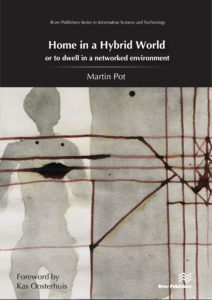artikel geschreven voor BNI’s themanummer 2017-4 over technologische innovatie; lees pagina 14-17.
“Soon, your house could betray you”
Rem Koolhaas, Artforum, April 2015
“It is only human choice that makes the human world function. Technology can motivate human choice,
but not replace it”.
Jaron Lanier, ‘You are not a gadget’
domus en/of technica ?
Domotica (ook wel huisautomatisering of smart homes[1] genoemd) is het toepassen van elektronica en huisnetwerken ten behoeve van de automatisering van processen in en om de woning. Het woord “domotica” is een samentrekking van domus (huis in het Latijn) en het achtervoegsel -tica dat lijkt te duiden op ’toegepaste wetenschap’.
Een definitie van domotica is: De integratie van technologie en diensten, ten behoeve van een betere kwaliteit van wonen en leven.[2] Bij domotica draait het dus niet alleen om integratie van techniek en bediening in de woning, maar ook om de dienstverlening van buitenaf naar de woning.
bron: Wikipedia.
Als er iets is dat de mens gemeen heeft de medemens is het dat allen ‘wonen’. Vanzelfsprekend verschillen vorm en kwaliteit, maar op enigerlei wijze hebben wij allen min of meer een dak boven ons hoofd. Tezelfdertijd is de mens een technisch wezen; in toenemende mate echter zorgt de combinatie voor frictie, met name daar waar menselijke waarden – b.v. de wens/noodzaak tot privacy – in het geding zijn.
Onze gebouwde omgeving vormt tevens de fysieke (wettelijke) basis voor het verschil tussen private en publieke ruimte; we hebben als individu het eerste nodig om te kunnen ‘acteren’ in het tweede. Zolang deze scheiding bestaat en de private ruimte een fysieke vertaling – de woning – nodig heeft zal deze geleefde ruimte ontwerp en technologie kennen.
Daarnaast; als wij woningen bouwen doen we dat voor ca. 100-120 jaar, de gemiddelde duur van bewoning in ons land is 7-10 jaar. Geen weldenkend mens zal kunnen voorspellen hoe de wereld eruit ziet over 25 jaar, laat staan over 100 jaar. Het is dus tamelijk pretentieus bij ontwerp te bepalen hoe komende generaties hun wonen moeten vormgeven zolang wij geen totale flexibiliteit inbouwen en daarmee wenselijke en/of noodzakelijke aanpassingen faciliteren.
Lees verder →

